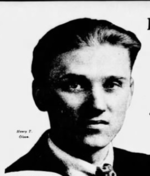 St. Louis Post-Dispatch, August 11, 1929. On the night of September 6, 1927, two young men shot Floyd Stotler, an oil station attendant, in a stolen sedan at the oil station garage in Rockford, Illinois. Orville Stotler, father of the victim, witnessed his son’s struggle with the men before they shot him, abandoned the car, and fled on foot. Shortly after being transported to St. Anthony’s Hospital, Floyd Stotler died. Two .22 caliber bullets were recovered from his body. Despite continual line-ups, Orville Stotler was unable to identify anyone as a suspect in his son’s death. A telephone tip in which the following statement was offered: “Get Henry T. Olson in the Stotler case” was the only clue in the investigation. Henry T. Olson was a 26-year-old bond salesman, living with his parents, Emanuel and Sarah Olson, and his new wife, at his parents’ home a block away from the garage. The police watched him for several days, then arrested him on September 13, 1927. On the same day, Olson hired respected attorney Harry North to defend him in the case. Olson’s first trial ended in a hung jury. Three witnesses supported Olson’s alibi that he was not at the scene of the crime. These three witnesses included his parents and a bus driver, James L. Donnett, who saw Olson around 9:00 p.m. on the night of the crime. His parents offered testimony stating that their son was at home at the time of the crime. At the second trial, North did not call the three witnesses to the stand and the jury delivered a guilty verdict on February 23, 1928, and Olson was sentenced to life in prison. Convinced that North’s failure to call witnesses was responsible for his conviction, Olson immediately hired a new lawyer, Frank E. Maynard, who filed a motion for a new trial. Olson was free on bond until his new trial began several days later. However, Olson immediately left town after his conviction. On February 27, 1928, a young housekeeper named Madeline Ackerson informed police that she knew Olson was innocent because she knew that George Bliss and Maurice Mahan were guilty of murdering Stotler. Bliss and Mahan were immediately taken into custody and confessed their guilt. Bliss, who had fired the fatal shots, stated that: “It was in my mind that if Olson could get away and not suffer the punishment, I wouldn’t say anything, but if he was going to suffer serious punishment, I was figuring on making a clean breast of it.” It should be noted that during Olson’s second trial, Harry North had also been representing George Bliss and Maurice Mahan in an unrelated case. The following day, February 29, 1928, the police began running newspaper advertisements advising Olson, who was still on the run, that his name had been cleared and he should return home to be formally exonerated. After seeing one of these notices, Olson returned home on or around March 4, 1928. On March 16, 1928, Olson was retried as a formality and quickly acquitted. His $10,000 bond was discharged. After his exoneration, Olson, convinced that North had been negligent, filed suit against him, claiming that he had failed to call alibi witnesses to the stand, failed to hire an expert to investigate the gun that had killed Stotler, and failed to ask Olson appropriate questions during his testimony. On the stand, Bliss told the court that he had confessed to North prior to Olson’s conviction. In 1933, Olson was awarded $29,250 in damages from North. In 1934, many of the claims in the lawsuit were reviewed by the Second District Illinois Court of Appeals, which determined that North had acted honorably and maintained good conduct. Based on Bliss’s personal record, the court did not believe his testimony that he had told North about his guilt prior to Olson’s conviction. The trial court reduced the amount of the original verdict by 75 percent, stating they believed that the original verdict was the result of “prejudice and passion” by the jury. – Researched by Komal Sawlani
|